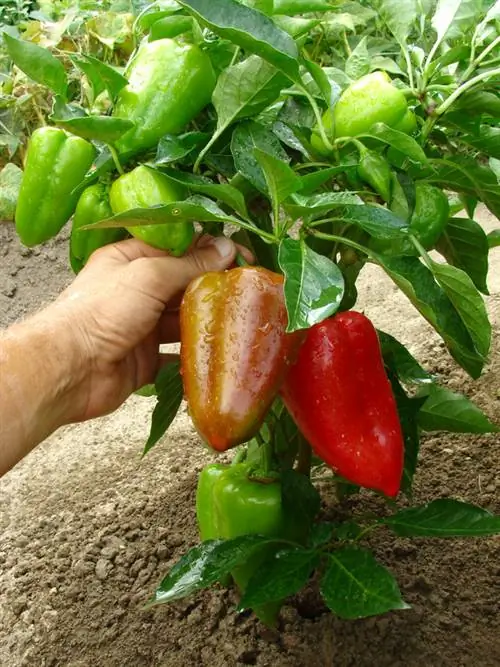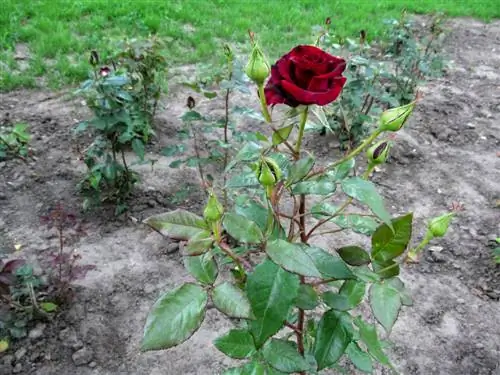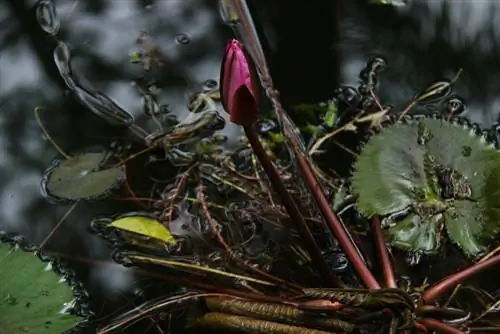- Author admin [email protected].
- Public 2023-12-25 17:45.
- Last modified 2025-06-01 06:02.
Peppers are among the vegetables with the highest vitamin C content. This usually only applies to organically grown peppers. In addition, whole organic pods are expensive. Every pepper lover will find the right spiciness here. Because planting peppers is worth it and not difficult.

How do I plant and care for peppers for a successful harvest?
To plant peppers successfully, start sowing in March, ideally in a mini greenhouse. Make sure you choose a warm, sunny location and loose, slightly acidic to neutral soil. Good neighboring plants such as borage or marigolds can help promote growth and fruit production.
How do pepper plants grow best?
If you want to plant your own peppers, you can grow young plants outdoors from mid-May or grow peppers yourself on the windowsill in March. When they are about 10 centimeters high, prick out the peppers and plant them individually in pots.
Don't plant peppers too early in the garden or on the balcony. They are very sensitive to frost and react to cold by stopping growth. Slowly get used to the outside temperatures. The plants can be placed in the greenhouse from the end of April or outdoors from mid-May.
What location do peppers want?
The be-all and end-all when growing peppers is the location. Therefore, before planting the peppers in the garden, check in good time whether the planned location meets the requirements of the selected pepper variety. Before growing peppers in the garden, check whether the optimal planting distance is available.
Sowing and planting peppers - what should you pay attention to?
Peppers need more space, warmth and light than other fruit vegetables. The young plants only germinate and thrive at temperatures of around 25° degrees. Sowing peppers before the beginning of March is not worth it. Correct timing is therefore important. Ideal soil conditions are also crucial for a he althy, abundant harvest. Peppers as a fruit or vegetable prefer a slightly acidic to neutral, sandy, loose soil. Enriched with compost and some primary rock powder. Plant the plants in the compost.
Does an early preculture keep its promise?
Growing peppers at the right time offers several benefits. The plants produce flowers earlier and produce ready-to-harvest pods more quickly. The pepper seedlings are also protected from wind, weather and snail attacks.
Replant peppers every now and then
If the young plants are too big for the sowing cups, repot them into larger pots from time to time. Even if the temperatures are still too cool for outdoors. Keep the pots warm and place them in a sunny window spot. Make sure there is enough drainage.
The best pepper planting stakes for free
Simple bamboo sticks or durable metal plant sticks, which are made simply or playfully as decorative plant sticks, keep the plants stable. Depending on the size, peppers attached to bamboo sticks offer a lively summer privacy screen on the balcony. The best chili plant sticks for free are available on New Year's Day. Simply collect the wooden stems from the New Year's rockets and use them as plant sticks.
Turn 1 into 2 with seeds or cuttings?
To propagate peppers, simply remove the seeds from fully ripe red pods, dry them and sow them from March. Allow the seeds to germinate in a mini greenhouse (€12.00 on Amazon) on a windowsill. This is how you can grow peppers yourself. Or cut head cuttings about 10 centimeters in size from existing plants. Remove most of the leaves and place in water or potting soil. Important: Cuttings only root after 3 to 4 weeks at a soil temperature of around 25° degrees. In order to continue to grow the peppers successfully, the temperature must not be below 22° degrees.
How do you recognize fully ripe peppers?
You can harvest the first peppers from July when the fruits have reached the desired color. Green pods ripen in approximately 3 weeks. Cut off the pods at the stem using scissors or a knife. Harvest the last peppers before the first frost. Regular harvest promotes fruit formation on the side shoots.
Good and bad neighbors with peppers
Combine borage and marigolds with peppers. These attract many insects for pollination. Fragrant herbs such as basil, thyme and onions keep pests away.
Good neighbors for peppers: peas, carrots, cabbage, tomatoes, eggplants and zucchini. The heavy-feeding pepper can only be planted in the same location every 3 years.
Tips & Tricks
When working with peppers and chili, always wear gloves and avoid contact between your hands and eyes! The capsaicin can cause painful irritation!






